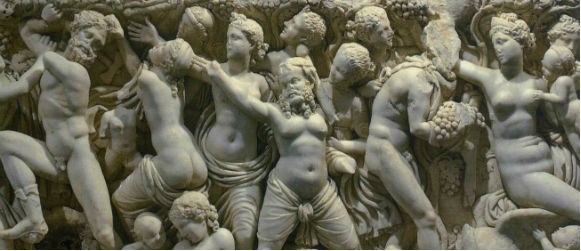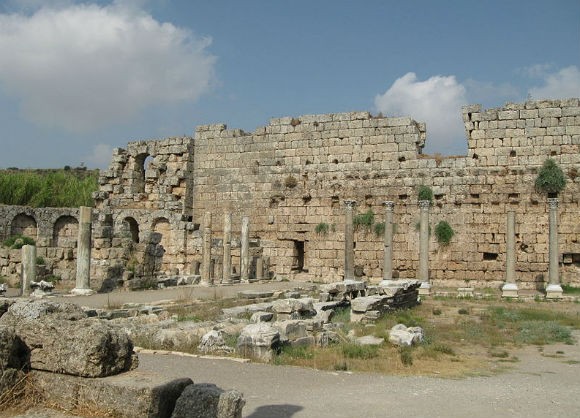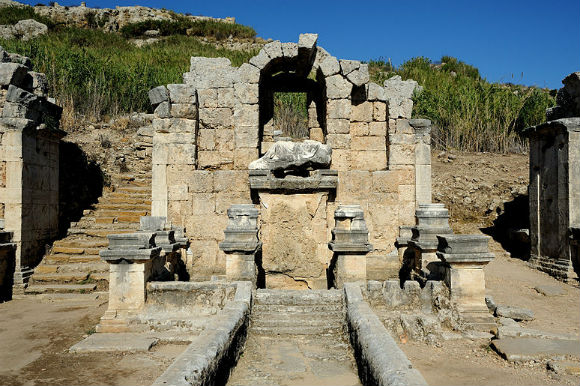Perga was an old city even in the first century. Its name (which is not Greek) indicates that its origin dates from pre-Greek times. Alexander the Great passed through it twice while the Pergaeans offered no resistance to him although it was a walled city with a citadel. In Roman times the main streets were over twenty-one meters wide. They were lined with Ionic colonnades and a water channel ran down their center in a series of small waterfalls as in Antalya today. Behind the colonnades stood the shops. Of the early buildings the stadium and the theater have survived the ravages of earthquakes and wars with the least damage. In fact this stadium which could seat about fourteen thousand people is one of the best preserved in Turkey.
The temple of the Pergaean Artemis according to a writer of the time was “a marvel of size, beauty, and workmanship.” Its location has yet to be established; it may have been where there are now ruins of a Byzantine church on a hill to the southeast of the city.
Perga is on a rise not far from the Cestrus River which was navigable In Paul’s time. It was not a seaport in terms of Its being directly on the Mediterranean even then, but rather it was more easily defended where it was: its distance from the open sea made it less vulnerable to piracy.
Two people stand out among the early residents of Perga. Apollonius was a third century B.C. astronomer and mathematician who believed that the movements of heavenly bodies in the universe were explainable by orbits within orbits: that the moon went around the earth as the earth went around the sun. He was much ahead of his time in his theories of astronomy, so much so that the ideas had to be rediscovered during the Renaissance. Plancia Magna was unusual for a second century A.D. woman: she held the highest city office during her life, that of demiurgus. She must have been well-to-do for a number of inscriptions record her gifts to the city.
Paul and Barnabas went through Perga on their way to and from Antioch on their first journey (Acts 13:13, 14:25). John Mark was with them at first but left them at Perga to return to Jerusalem. The reason for that must have been such that Paul doubted his commitment to the cause. Later when Paul and Barnabas were about to start on their second journey from Antioch they had a sharp dispute over his worthiness. Paul refused to have him go along, so John and Barnabas went to Cyprus while Paul chose Silas to accompany him.
Paul talks in II Corinthians 12:7 and in Galatians 4:13-14 of bodily illness that brought him to Galatia the first time. It may have been on that account that he did not stay long in Perga the first time. Whatever the illness was, it seems to have improved in time in the dry mountain air to the north.
The second theory of why they did not stay long in Perga is that their interview with Sergius Paulus, the proconsul of Cyprus, had made them want to hurry to the Roman colony in Antioch of Pisidia. This interpretation may lay too much stress on the lasting importance of that meeting with a cultured Roman who could have been more interested in the pursuits of the mind than the salvation, in Christian terms, of his soul. It is interesting, however, that this is” the point in Acts (13:9) that Luke begins to call Paul by his Roman name, not his Jewish “Saul”.
On their return they did stay in Perga long enough to preach and talk with people there. Nothing else is told about the city or their time there.
Perga,






We've been to a lot of ruins in Turkey, and these are fabulous. There is a lot to see, but the site is flat and sandy, so it is an easy walk. Many of the building still have high walls intact, which is unusual. The baths are particularly interesting, and the agora is massive with re-erected columns on all four…
This well preserved site was amazing. So much to see and take in. Not only the city but also the stadium and amphitheatre outside. My history loving son was awe struck by the sights. Beware the temperature can get very hot. Take plenty of water and sensible shoes as the terrain is quite rough.
The tickets are a quite reasonable 15TL and the site is reasonably well preserved. Some areas are closed for further excavation (most notably the theater area), but the rest is well presented and quite well restored. There are a lot of pieces strewn about, seemingly waiting to be better presented or catalogued, but they do not impede the viewing of…
We took a trip to Perge to see the ruins of an ancient city. It was well worth the trip. Smaller than Ephesus it was still remarkable to stand in a place so old.,
Turkey is just awash with Roman cities,buildings and artifacts.Thought I'd seen it all with Ephesus and Apollo Temple,Aspendos then we saw this place,just blows you away.Buildings for the rich and poor,Temples,roads,ampitheatre,fighting arena and chariot racing arena,could spend all day walking round this place and go back the next day.If you like history and how the romans lived then this is…
We took the bus tour to Perge & Aspendos from Side. If you are interested in ancient history this is a great site to visit. Founded around 1000 BC and credited as one of the first cities to produce beer all beer lovers should make a pilgrimage to this site. In 333 BC the armies of Alexander The Great arrived….
I didn't expect much from ruins in Turkey but was pleasantly surprised. I would recommend the tour featuring Perge, Apendos and the waterfall.
Perge is very impressive little city located a few km from Antalya. It's very easy to get there by car ( but I am sure that also by buses) as it's just of the highway.
Impressive ruins where you can walk in the old street see the shops were in the Agora area and the big baths. They had 3…
Perge is simply that. Having stumbled around Termessos and fought our way around Sillyon, the access to Perge is a much appreciated relief. The site is pretty much on the level and, architecturally, it has more to offer the visitor than any other Roman/Hellenic Pamphylian city. The large bath complex has some stunning marble columns, although wherefrom I don't know….
A great example of a Roman town and you could imagine living in these times. There was no shade and little in the way of refreshments or resting places. For the truly dedicated